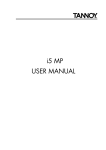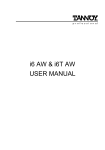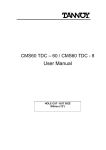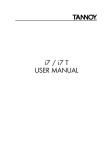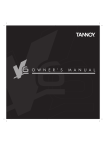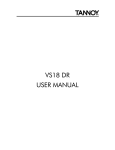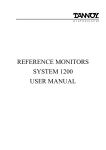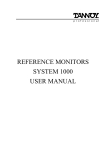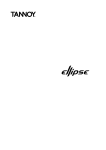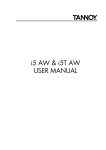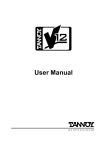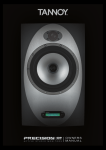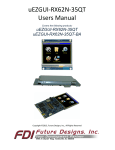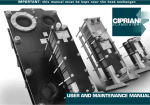Download CMS50 User Manual
Transcript
CMS50ICT & CMS50T ICT USER MANUAL HOLE CUT-OUT SIZE 210mm 2 CONTENTS 1. Introduction 2. Unpacking 2.1 CMS50 ICT / CMS50T ICT The Product The C-ring The Tile Bridge and C-ring The Plaster ‘Mud’ Ring 3. Installation Instructions 3.1 3.2 3.3 3.4 3.5 Hole Cut Out Connections Installation Speaker Assembly with C-ring Speaker Assembly with Tile Bridge and C-ring 4. Polarity Checking 5. Amplification and Power Selection (Low Impedance Mode) 6. Voltage and Power Selection (Distributed Line Operation) 7. Equalisation 8. Dimensions 9. Performance Data 10. Technical Specifications 11. CMS60 ICT Recommended Service Parts & Accessories 12. Warranty 13. Declaration of Conformity 3 1. Introduction Thank You for purchasing Tannoy CMS50 ICT Ceiling Monitor System. The Tannoy CMS50 ICT Ceiling Monitor System is suited for high-level music and speech reinforcement applications requiring exceptional sonic quality with uncompromised reliability. Achieving fast, simple and cost effective installation in new and existing buildings, this versatile design has addressed the two most common failures of background music and sound reinforcement systems, which are firstly the tweeter, and secondly the crossover. With the revolutionary design of the ICT™ drive unit, neither of the above criteria applies, assuring you years of trouble free use. ICT™ or Inductive Coupling Technology utilises a wireless electromagnetic tweeter that does not require a crossover and cannot be burned out from heavy or abusive use. The 1” aluminium high frequency dome has a deep drawn skirt that sits on the inside of the low frequency voice coil in the same magnetic gap. The skirt is like a single shorted turn, which is induced with high frequency information generated by the low frequency voice coil, which is fed a full bandwidth signal. The ICT™ dome is at the heart of our 5” ceiling transducer which utilises a moulded plastic cone and nitryl rubber surround to further enhance it’s durability and long term reliability. The ICT driver is housed in a rugged aluminium ceiling enclosure that has been optimally tuned to achieve maximum bass response and tonal balance. The CMS50T ICT houses a Tannoy THP 30 multi-tap transformer for distributed-line operation. The transformer provides high system sensitivity, a wide bandwidth and dynamic range, with very low insertion loss. For critical Applications provision has been made for the CMS50T ICT to accept the THP 60, a 60W multi-tap transformer. 2. Unpacking Every Tannoy CMS50 ICT and accessory is carefully inspected before packing. After unpacking, please inspect your CMS50 ICT to make sure no damage has occurred in transit. In the unlikely event of any damage, would you please notify your dealer immediately and retain your shipping carton, as your dealer may ask you to return the faulty unit to him for inspection. The CMS50 ICT is packed in pairs, and any additional optional extras will be provided in separate packaging. These options include: C Ring, Tile Bridge and Plaster Ring. 4 2.1. CMS50 ICT Product Wiring Cover Speaker Grill Back Can Speaker Baffle C Ring (optional) Tile Bridge and C Ring (optional) Plaster Ring (optional) 5 3. Installation Instructions 3.1. Cut-Out The cut-out size required is 210mm. 3.2. Connections The CMS50 ICT is provided with a plugable European type connector, which is located on the back of the speaker can, under the wiring cover as shown in Figure 3a below. This consists of a plug and socket. The plug can be removed from the socket (Figure 3b) for wiring. Figure 3a Figure 3b To cable is inserted into the hole on the side of the plug, and the screw is tightened to secure the cable in the plug. The plug is wired to the amplifier such that the connections are as follows: Pin 1 is Positive Pin 2 is Negative For additional speakers, pin 3 and 4 are in parallel with pins 1 and 2, where: +--+ Pin 3 is Negative Pin 4 is Positive Before connecting the speaker, ensure the wiring cover and cable clamp on the back of the can are open as shown in Figure 3c. Connect the wired plug into the socket. Figure 3c 6 Once the plug has been connected, close the wiring cover and tighten both screws on the cable clamp in order to secure the cables in place as shown in Figure 3d, below: Figure 3d If conduit has to be installed then a conduit squeeze connector can be used instead of the cable clamp. To remove the cable clamp simple unscrew the threaded washer (under the wiring cover) which holds the cable clamp in place and replace with the conduit squeeze connector. The CMS50 ICT will accept a squeeze connecter with a thread size of up to 21mm (3/4”) Figure 3e 7 3.3. Installation The CMS50 ICT is supplied as a complete product, ready for installation. An optional C Ring, Tile Bridge and Plaster Ring are available if required. The CMS50 ICT has been designed for ease of installation. To install the speaker, connect the speaker as described in the section 3.2. The speaker has 3 tags (Figure 3f) that hold the speaker in place. Ensure these tags are flat against the can before installing into the ceiling. Tags for fastening speaker Screws for tightening tags Figure 3f Slide the speaker through the 210mm hole, as shown in figure 3g, and tighten the outer screws on the front baffle. Tighten these screws until a secure grip is established as shown in Figure 3h. Figure 3g 8 Figure 3h 3.4. Speaker assembly with C-ring To spread the weight of the 3 dog tags, an optional C-ring is available for the CMS50 ICT. To install the speaker in the ceiling, place the C-ring behind the tile. Slide the speaker assembly through the hole (Figure 3h) and tighten the dog tag screws, until a firm grip is achieved, (Figure 3i). Figure 3h Figure 3i 9 3.5. Speaker assembly with C-Ring and Tile-bridge If the speaker requires additional support, an optional Tile-bridge is also available for use in conjunction with the C-Ring. This is assembled as shown in Figure 3j. The Tile Bridge is attached to the C-ring, and the tile bridge supports placed either on the side railings or inside the railings, depending on the size of the panel. Slide the speaker assembly through the hole (Figure 3j) and tighten the dog tag screws, until a firm grip is achieved (Figure 3k). Figure 3j Figure 3k 10 3.6. Speaker assembly with Plaster (Mud) Ring An Optional Plaster ring can be used if a conventional ceiling tile is not being used. The wings on the plaster ring are attached to the building structure via the holes provided (Figure 3l). T. The dimensions can be seen in Figure 3l. The plaster is applied over the bracket. Figure 3l Important: Connect a safety cable to the rear of the speaker can. NOTE: the installation of this product must be carried out in conformity with local building codes and standards. If necessary consult your local safety standards officer before installing any product. Alternatively, check any laws or bylaws. Tannoy will not be held responsible for any damages caused by the improper installation of loudspeaker. 11 4. Polarity Checking It is most important to check the polarity of the wiring. A simple method of doing this without a pulse based polarity checker is as follows: Connect two wires to the +ve and -ve terminals of a PP3 battery. Apply the wire which is connected to the +ve terminal of the battery to the speaker cable leg which you believe to be connected to the red speaker terminal, and likewise the -ve leg of the battery to the black speaker terminal. If you have wired it correctly the LF drive unit will move forward, indicating the wiring is correct. All that remains now is to connect the +ve speaker lead to the +ve terminal on the amplifier and the -ve lead to the -ve terminal on the amplifier. If, however, the LF driver moves backwards, the input connections need to be inverted. If problems are encountered, inspect the cable wiring in the first instance. It should also be noted that different amplifier manufacturers utilise different pin configurations and polarity conventions. If you are using amplifiers from more than one manufacturer, check the polarity at the amplifiers as well as the loudspeakers. 5. Amplification & Power Selection As with all professional loudspeaker systems, the power handling is a function of voice coil thermal capacity. Care should be taken to avoid running the amplifier into clip (clipping is the end result of overdriving any amplifier). Damage to the loudspeaker will be sustained if the amplifier is driven into clip for any extended period of time. Headroom of at least 3 dB should be allowed. When evaluating an amplifier, it is important to take into account its behaviour under low impedance load conditions. A loudspeaker system is highly reactive and with transient signals it can require more current than the nominal impedance would indicate. Generally higher power amplifier running free of distortion will do less damage to the loudspeaker than a lower power amplifier continually clipping. It is also worth remembering that a high powered amplifier running at less than 90% of output power generally sounds a lot better than a lower power amplifier running at 100%. An amplifier with insufficient drive capability will not allow the full performance of the loudspeaker to be realised. It is important when using different manufacturers amplifiers in a single installation that they have very closely matched gains, the variation should be less than +/-0.5dB. This precaution is important to the overall system balance when only a single compressor/limiter or active crossover is being used with multiple cabinets; it is therefore recommended that the same amplifiers be used throughout. 6. Voltage & Power Selection (CMS50T ICT) When using 70.7V or 100V distributed-line systems, the transformer can be tapped at 30W, 15W and 7.5W, with an extra 3.75W tapping for 70.7V line systems. A the tap are selected via a rotary switch, as shown in Figure 4a, and is located on the front of the unit, behind the grille, Figure 4b. When the relevant voltage tappings have been selected add the individual power in Watts at all speakers and select and amplifier with a rating equal to or exceeding the total power in Watts. All of the transformer primaries should be connected in parallel to the output of this amplifier. If for example, you select the 7.5-watt transformer tap, it means that at full rated amplifier output the speaker will receive the full 7.5 watts. If the amplifier gain is reduced each speaker will receive a proportional amount of power, maintaining the overall system balance. It is recommended that a generous power safety margin (3dB of headroom) be left so that the system does not have to operate continuously at its full rated output power. 12 Figure 4a Figure 4b In order to comply with relevant fire safety regulations (i.e. BS 5839:1998), it is required that in the event of fire, that failure of the circuit to which the loudspeaker is connected does not occur before evacuation of the building is complete. Suitable measures include: a) use of terminal blocks (for connection to primary) with a melting point of not less than 650°C, for example constructed from ceramic materials; c) use of terminal blocks of a lower melting point but protected with thermal insulation; d) use of terminal blocks such that, on melting, an open-circuit or a shortcircuit does not occur. 13 7. Equalisation The CMS50 ICT is designed to need no equalisation or correction to overcome system limitations. As a result, it will only need equalisation to compensate for difficult acoustic environments. Excess equalisation can reduce system headroom, and introduce phase distortion resulting in greater problems than it cures. If equalisation is required then it should be applied gently and smoothly. Violent equalisation will be detrimental to the overall sound quality. If the loudspeakers were being used consistently at high levels it would be beneficial to introduce a high-pass filter at 50Hz to protect the loudspeaker from any unnecessary subsonic frequencies 8. Dimensions 14 9. Performance Data 120 105 dB 90 75 60 45 50 500 100 1,000 5,000 10,000 50,000 Frequency Frequency Response 18 15 Ohms 12 9 6 3 0 2 10 100 1,000 10,00020,000 Frequency Impedance Response Beamwidth vs Frequency 360 330 300 270 Degrees 240 210 180 150 120 90 60 30 0 100 1000 10000 Frequency (Hz) 10. Technical Specifications 15 System Type Vented, full range ICT™ loudspeaker system Frequency Response (1) +/- 3dB 85-22kHz Power Handling(2) 50 watt Sensitivity (1) 2.83 volt @ 1m 90 dB Maximum SPL (3) @ 1m 105 dB with THP 30 Transformer (Anechoic) 108 dB with THP 30 Transformer (Half-space) 107 dB @ 8Ω (Anechoic) 110 dB @ 8Ω (Half-space) Impedance Nominal Minimum DI Averaged @ 500Hz @ 1kHz @ 2kHz @ 4kHz @ 8kHz @ 16kHz 3.52 4.44 3.40 10.30 10.81 11.95 Q Averaged @ 500Hz @ 1kHz @ 2kHz @ 4kHz @ 8kHz @ 16kHz 2.25 2.78 2.19 10.73 12.06 15.67 6 ohm 4 ohm Driver Complement 1 x 5” (130mm) full range, ICT™ Point Source Enclosure 4.21 litres, vented with integral steel back can Finish White System Weight (in back can) (CMS50 ICT) 2.6kg (5lbs 13oz), (CMS50T ICT) 3.1kg (6lbs 14oz) Dimensions Can height: 187mm (204mm including tie-back ring) Baffle Diameter: 240mm Back can diameter: 208mm Hole cut-out 210mm Accessories C Ring (optional) Tile Bridge (optional) Plaster Ring (optional) NOTES: (1) Average over stated bandwidth. Measured at 1m on axis, in an anechoic chamber. (2) Long term power handling capacity as defined in EIA standard RS - 426A. (3) Unweighted pink noise input, measured at 1m. Tannoy operates a policy of continuous research and development. The introduction of new materials or manufacturing methods will always equal or exceed the published specifications which Tannoy reserve the right to alter without prior notice. Please verify the latest specifications when dealing with critical applications. 16 11. CMS50 ICT Recommended Service Parts & Accessories Part Number 7900 0571 8001 1840 8001 1920 8000 1910 8000 1900 Description Driver Kit – 5” ICT Type 1214 CMS50 ICT Loudspeaker CMS50 ICT C Ring CMS50 ICT Tile Bridge CMS50 ICT Plaster Ring 12. Warranty No maintenance of the CMS50 ICT loudspeaker is necessary. All Tannoy professional loudspeaker products are covered by a 5 year warranty from the date of manufacture subject to the absence of misuse, overload or accidental damage. Claims will not be considered is the serial number has been altered or removed. Work under warranty should only be carried out by a Tannoy Professional dealer or service agent. This warranty in no way affects your statutory rights. For further information please contact your dealer or distributor in your country. If you cannot locate your distributor please contact Customer Services, Tannoy Ltd at the address given below. Customer Services Tannoy Ltd. Rosehall Industrial Estate Coatbridge Strathclyde ML5 4TF Scotland Telephone: Fax: e-mail: 01236 420199 +44 1236 420199 01236 428230 +44 1236 428230 [email protected] (National) (International) (National) (International) DO NOT SHIP ANY PRODUCT TO TANNOY WITHOUT PREVIOUS AUTHORISATION Our policy commits us to incorporating improvements to our products through continuous research and development. Please confirm current specifications for critical applications with your supplier. 17 13. Declaration of Conformity The following apparatus have been designed in Great Britain and conform(s) to the protection requirements of the European Electromagnetic Compatibility Standards and Directives relevant to Domestic Electrical Equipment. The apparatus is designed and constructed such that electromagnetic disturbances generated do not exceed levels allowing radio and telecommunications equipment and other apparatus to operate as intended, and, the apparatus has an adequate level of intrinsic immunity to electromagnetic disturbance to enable operation as specified and intended. Details of the Apparatus: Tannoy Ceiling Loudspeaker Model Number: CMS50 ICT Associated Technical File: EMC CMS50 ICT Applicable Standards: EN 50081-1 Emission EN 50082-1 Immunity EN 60065 Electrical Safety: Signed: Position: Products Engineering Director – Professional Tannoy Professional Date: For Tannoy Ltd 18 10/01/2005 19 Tannoy Loudspeakers are manufactured in Great Britain by: Tannoy Ltd, Rosehall Industrial Estate, Coatbridge, Strathclyde, ML5 4TF, SCOTLAND Telephone: +44 (0) 1236 420199 Fax: +44 (0)1236 428230 Tannoy North America Inc, Suite 1. 335 Gage Avenue, Kitchener, Ontario, CANADA, N2M 5E1 Telephone: (519) 745 1158 Fax: (519) 745 2364 Issue 2 Part No. 6481 0429 GH Jan 20th, 2005 20





















